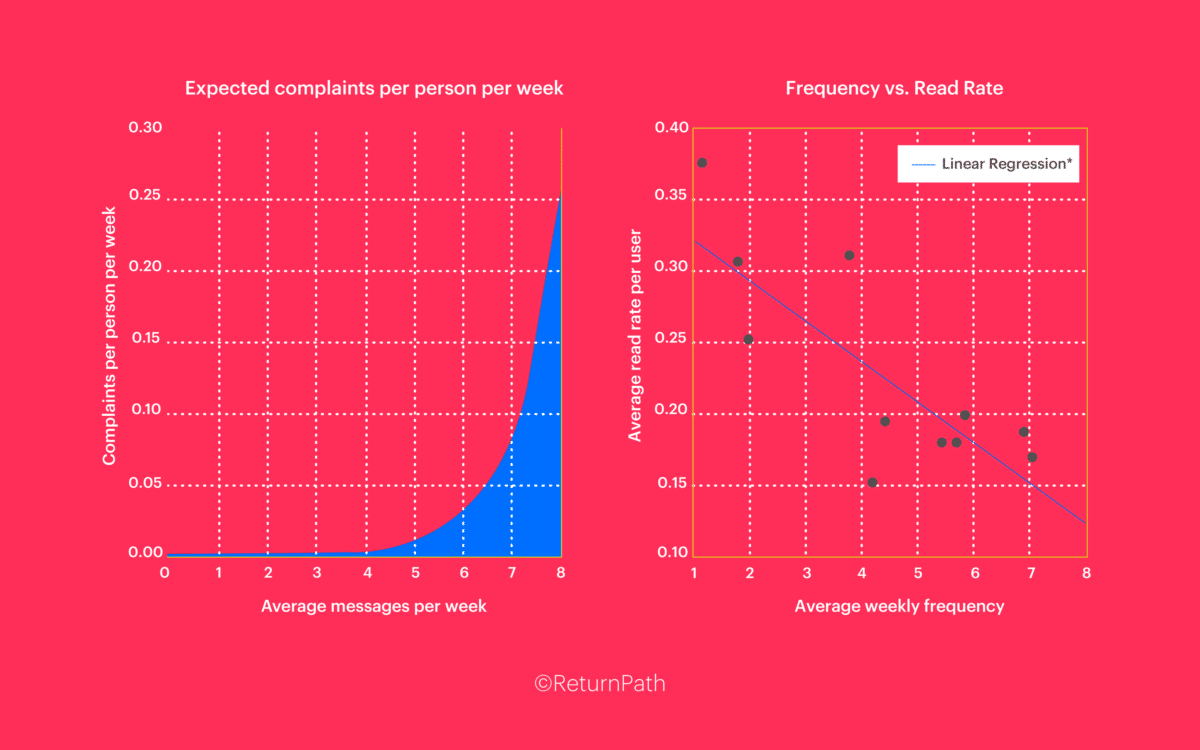Email marketing frequency: How often should you send marketing emails?

How much is too much in email marketing? At what point do your helpful and informative messages turn into annoying spam? Do some customers prefer to receive more emails than others?
Those questions have plagued companies all over the digital landscape for years. Unfortunately, there’s no one-size-fits-all answer we can give you.
Email frequency is a complicated thing. How often you should send emails to customers depends on a variety of factors, including what kind of industry you’re involved with, what your clients prefer, and even what your emails are about.
Every marketer has their own idea about what the perfect frequency might be. Notably, if you send too many emails too fast, you’re going to frustrate your audience and send them running in the wrong direction.
Alternatively, send too few messages, and you may fail to keep your brand “front of mind” for your customers.
So how do you figure out which email frequency is right for you?
How often should you send marketing emails?
Let’s start this guide with a brief introduction to what email frequency actually means.
Email timing refers to the day and time you send each email, and it’s important in its own right, but email frequency describes how many times per week, month, or day you send those messages.
There’s no universal truth indicating which frequency is best. It fully depends on your brand, your chosen audience and your email marketing strategy.
It’s easy to assume sending more emails means you’ll have more opportunities to engage your audience and create sales.
While staying in touch with customers is an important part of your digital marketing efforts, nobody likes a company that’s constantly flooding their inbox.
One insurance company in a case study here managed to improve the revenue it gained from its email marketing campaigns by increasing the frequency of its marketing messages. That is why email marketing for insurance agencies should never be underestimated as a tool for getting more leads.
At the same time, a retail store suffered from a significant decrease in average daily revenue after boosting frequency. Sales decreased from $696.50 to only $475 when they changed from three emails, to four a month.
Your email frequency has a direct impact on your open rate, your unsubscribe rate, and your customer’s engagement. According to Campaign Monitor, after studying 2 billion emails, the companies with the highest open rates sent around 5 campaigns every month.

Unfortunately, numbers like that won’t apply to every company. Email marketing frequency best practices differ depending on a variety of important factors.
Calculating the right number of emails, you should be sending each month starts with a careful evaluation of your target audience.
Looking at your audience personas will give you a view of the kind of people you’re connecting with in this new digital landscape. There are some consumers who don’t mind hearing about sales and discounts on a daily basis – if they’re particularly interested in your product.
Others will get annoyed if you send more than one email per week.
Notably, the more you examine your target audience, the more you’ll notice there’s probably more than one group of customers you need to consider with your email strategies.
That’s why so many email marketing software solutions come with segmentation tools which allow you to split your clients into different groups.
As you learn about your customers and their individual preferences, you can choose sending frequencies based on what you consider to be the most effective strategy for each group.
The science of email frequency: How to calculate it
Since it takes a while to get to know your customers and figure out which frequencies really work best for them, it makes sense that you’d need a starting point for your campaigns.
The data generally suggests every two weeks is the “sweet spot” when you’re just getting started with email marketing. Although the benchmarks can shift according to industry.
DMA data reveals marketers generally think they send around 21 emails on average per week, while customers feel they receive more than double from various brands.
This data indicates that even if you think you might not be sending too many emails, your customers may not agree.
Figuring out your subscriber’s preferences can be a complicated process, but there are a few steps you can take to get on the right path:
Understand your audience
As mentioned above, examining your user personas will help you to better understand your customers and what they need from you. If your audience is full of B2B executives with inboxes constantly overflowing, marketing emails from you are just going to be annoying.
On the other hand, if your audience features stock market investors, they might prefer more regular updates.
Study the customer journey
The journey your customer takes from discovery through to purchase and beyond will have a huge impact on email cadence. Understanding the various touchpoints along the customer journey will help you to anticipate when to send the right content at the appropriate time.
Timing your send cadence to suit your customer’s needs will help to guide them through the journey without disruption.
Ask for their preferences
The easiest way to figure out how many emails your customers want to receive from you, is to simply ask them. An email preference centre allows your clients to take control on how many emails they want to receive from you, and what they want to hear about.
This can reduce your risk of unsubscribes. Include a link to your preference centre in every email.
Send surveys
Alternatively, just get a better overview of your entire audience by sending surveys to your customers. This will allow you to create more comprehensive segments based on the individual preferences of different groups.

How much is too much in email marketing?
Most experts agree they get the best experience from their email marketing when they send one or two emails per week. Your optimal frequency depends on your subscribers and your store, but it might be a good idea to start with one or two a week and work up.
To help get you started as quickly as possible, let’s check some best practices for email marketing frequency.
- Try sending at least one email per week. This could be a transactional, relational, or promotional email, depending on your audience. Less than one email a week could mean that your audience becomes disengaged.
- Sending one or two automated email campaigns to each list is usually a good idea for most merchants as a starting point. However, you should always make sure you have tracking systems in place to help you measure your results.
- Make sure every email you send has value before you send it. The content you deliver to your customers should always be beneficial to them. If you’re repeatedly sharing the same information, then you’re going to drive your customers away.
- Adapt your email frequency to each segment of your audience. Don’t assume everyone in your list will want the same number of emails. Adjusting your plan based on the results you gather from each segment will lead to better results.
- Use send time optimization features if you can. There are a lot of email marketing software solutions out there that include things like machine learning algorithms to help you determine which frequencies are right for you.
Remember, it’s also possible to send the same email more than once in some cases. You can take the same email, change the subject line, and send it again to people who haven’t opened the content before.
This gives you another chance to engage your audience without doling out new content. It also means increasing your send frequency for some subscribers won’t mean you need to spend a fortune on new campaigns.
Top tips for better email frequency
Both high email frequencies and low email frequencies have their pros and cons to consider. On the one hand, if you send emails very often, you might end up with customers getting frustrated, or sending your messages into the junk folder.
On top of that, it’s pretty time consuming to come up with new email campaigns all of the time. However, a higher frequency also delivers more chances for you to connect with your target audience and build a relationship.
Low email campaign frequency means you run the risk of your customers forgetting about your brand completely. Your sales could decrease because you’re not engaging your audience enough, and loyalty could drop.
However, lower frequencies also mean you’re less likely to expose your audience to email fatigue. You can even invest more time and money into creating the best campaigns if you run campaigns with less frequency.
Here are some top tips to help you calculate the right solution:
1. Keep up with changing standards
The email standards companies follow and the preferences of customers are constantly changing. In the 2018 Global Benchmark report, companies were sending less emails per month, according to SendGrid, but they were also seeing open rates increase.
Findings in 2020 revealed sending 2 to 4 emails per month had the best outcome for many companies, indicating less is more in the new digital landscape.
When you’re looking for an initial benchmark to begin testing email frequency with, remember that a lot of the advice out there could be a little outdated by this point. Just because customers loved a certain frequency five years ago, doesn’t mean the same rules apply now.
Staying up to date with the latest marketing trends will help you to make the right choices.
Additionally, keeping up with changing standards also means you’ll know when to build on your emarketing efforts with extra strategies, like SMS and social media marketing.
2. Understand the diminishing returns curve
Almost all of the research on email marketing frequency suggests the same thing. Increasing email frequency has a curve of diminishing returns. Even if your content and offers are great, the more you send, the more you’re going to annoy your audience.
Look at this graph from Return Path:

The tough part for marketers here, is the sweet spot you want to get to before the curve heads downwards, can differ depending on your industry and audience. You need to do some testing to figure out how you can get the best response, without going over the edge.
Return Path’s study suggests most customers will tolerate no more than 5 emails per week, so make sure you don’t go over that number.
3. Embrace the different parts of your audience
Just because most customers will tolerate 5 emails per week, that doesn’t mean they’re all going to be happy about it. Every audience is different, and there may even be unique segments within your audience have different needs when it comes to email frequency.
To ensure that you’re delivering the right experience to each customer, you’ll need to analyze your list. One case study found increasing their email frequency to just 2 messages a week caused their subscribers to suddenly shrink due to opt-outs.
Experiment with the needs of different segments within your audience and find out what works best for your email frequency. You might even decide to segment the customers in your list by their engagement level.
Maybe you have some customers that always open your emails, and others that open about half? This gives you an insight into where you can get started with frequencies.
4. Set expectations
When it comes to the question “how often should you send marketing emails?”, it’s important to remember that the best frequency doesn’t just rest on what works for your marketing department. You need to understand the individual needs of your customers too.
Some consumers will be happy to accept a more regular email marketing frequency, while others will expect less. Either way, it’s important to set expectations early. According to Marketing Sherpa, less than 20% of people want daily emails.
If you start sending a slew of messages to the wrong people, they may unsubscribe, or send your messages to junk, which harms your deliverability.
Setting expectations early, by telling your customers which frequency to expect, means you can reduce your risk of issues. Remember, if your deliverability rate suffers because of unhappy customers, then your domain reputation will struggle too.
This could mean that email service providers send your messages straight to spam.
5. Base email frequency on customer lifecycle
Ultimately, there’s no one ideal email frequency that works for all customers. Some companies will benefit from sending multiple emails per week, while others will only annoy their customers and send them in the opposite direction.
Usually, the best bet is to base your email marketing frequency on the purchase cycle of your typical customer. For instance, you’d send a welcome email when someone signs up for your service, then follow up in 3 months when you know most of your clients are likely to renew.
For fashion brands, there’s a particularly fast repurchasing frequency in action, which means you can send anywhere up to 6 emails a week without overwhelming your audience.
On the other hand, if you were a SaaS company sending the same number of emails per week about a monthly subscription software, wouldn’t make much sense.

Finding the perfect email frequency
Experimentation is the name of the game with email marketing frequency.
The guidelines and benchmarks mentioned above should give you some initial guidance on where to start with your research, but it’s up to each individual brand to find out what works best for their customer.
Finding the right email marketing frequency means experimenting with different strategies and tracking your results over a controlled period of time.
There are tons of A/B testing tools and email marketing software solutions that can help you to gather the information you need to make the right decisions.
You might even find you get better results if you combine marketing emails with the right selection of relational and transactional messages.
It’s also worth remembering although all of your customers might have some things in common – they’re all indivduals. Different segments of your email list will potentially respond differently to certain email frequencies.
Testing your campaigns on different groups that are identified by their behavior, engagement levels, and other features will increase your chances of success.
Fabrik: A branding agency for our times.
Now read these:



















